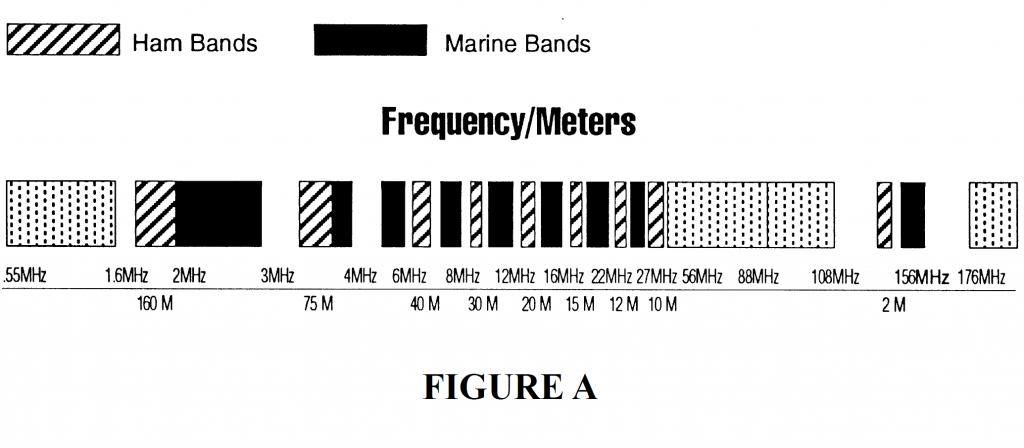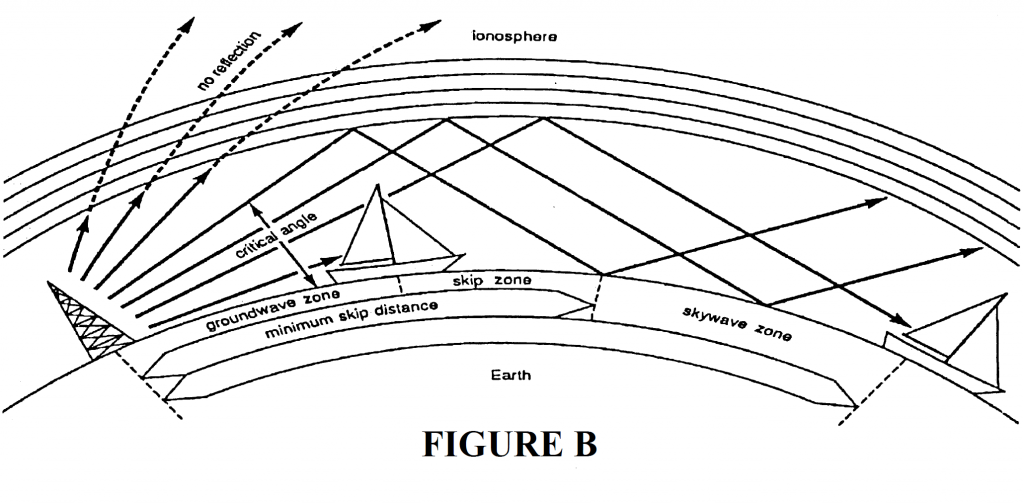Marine single sideband transceivers broadcast in the “high frequency” range of the radio spectrum. Unlike VHF (very high frequency) communications that always travel line-of-sight, transmissions in the “high frequency” region take advantage of Mother Nature for some extra long distance communications.
As of July 1, 1991, the following frequency bands have been allocated for marine single sideband service:
2 MHz 6 MHz 12 MHz 18 MHz 25 MHz
4 MHz 8 MHz 16 MHz 22 MHz 27 MHz

When transmitting on any band, one component of your radio signal hugs the surface of the ocean. This is called the ground wave. Ground waves that hug the surface of the earth and ocean travel approximately 50 to 200 miles from your transmitter. If you are communicating on single sideband with a nearby shore station or another boat less than 100 miles away, chances are it’s the ground wave component of your signal that’s doing all the work. Your ground wave signal is always there, day or night, and does not depend on anything other than a good, strong transmitted signal.
Good ground wave coverage out to 150 miles depends on a good antenna and a good radio frequency ground system aboard your boat. The better your antenna and grounding, the further you can communicate via ground waves. More on this later!
It’s the “sky wave” component of your transmitted radio signal that gives you long distance, single side band range. Sky waves are the components of your transmitted radio signal that travel up into the air and bounce off of the ionosphere and are reflected back to earth hundreds and even thousands of miles away.
The ionosphere surrounds our globe and is present 24 hours a day. Its density and reflecting capabilities change with day and night, the season of the year, and the 11-year solar cycle. Hanging like an invisible radio mirror between two stations, the ionosphere is responsible for reflecting back to earth marine SSB waves that strike it at the right angle.
“The right angle” to establish communications with a station, let’s say 3,000 miles away, depends on the time of day you are broadcasting and the particular band of frequencies you are using. Lower frequencies tend to bounce back to earth close in. Frequencies around 12 MHz tend to bounce back to earth over fairly long distances, typically 3,000 miles. 22 MHz may give us the longest bounce, enabling you to communicate from the West Coast of the United States into the Mediterranean. If the ionosphere is very strong, you may get a second bounce off your sky wave signal, which enables you to talk twice the distance that you normally would. On 22 MHz, this means that you can easily talk all the way around the world on a double-hop or triple-hop transmission.
The ionosphere is constantly changing, and a frequency that you communicated on yesterday might not be suitable for communications today. Often the time of day and season of the year will make a difference. When band conditions change in the ionosphere, you simply change frequencies on your ICOM to maintain a good, clear signal. With multiple frequencies and multiple bands available, you can stay in touch as the ionosphere goes through its regular ups and downs.

At night, the ionosphere gradually lowers. Your signals won’t be able to bounce as far, however, you will still enjoy several thousand miles of communications range.
During daylight hours, the ionosphere rises, giving you longer range on higher frequencies. Since it’s the sun’s rays that charge up the ionospheric layers, solar and other disturbances will sometimes enhance— and sometimes occlude—single sideband marine communications.
Sky waves are unaffected by local weather conditions. Whether it’s sunny or cloudy, snow or rain, windy or still, your sky wave range will not be influenced by local weather conditions.
Did You Know?
The only time you will hear “weather noise” on your transceiver is in the proximity of lightning and thunderstorms. Lightning may be picked up as far away as 200 miles on lower frequencies. It sounds like a static crash at the exact same time that you see the bolt illuminate. Some mariners leave their SSB radio turned on while cruising at night in inclement weather to get prepared for storm cells. When they hear it on the radio they should be prepared to see it soon!
After a few weeks of playing around with your new single sideband radio telephone, you will begin to get a feel for the expected range on any one particular band of frequencies. In our next chapter, we’ll give you some secrets!